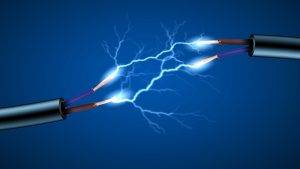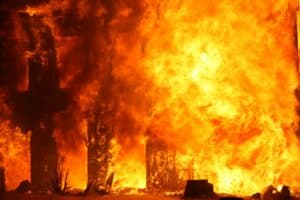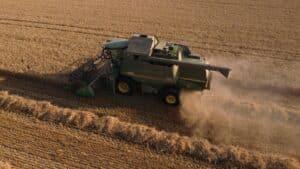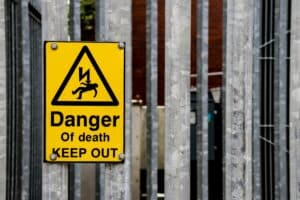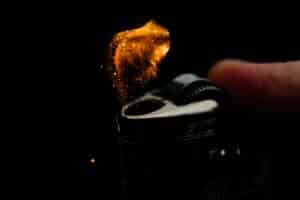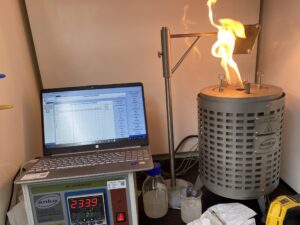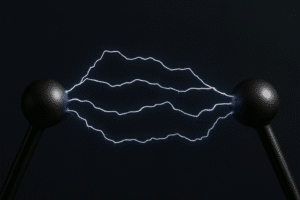We also offer
What Does Minimum Ignition Energy Mean?
Minimum Ignition Energy (MIE) is the lowest voltage spark capable of igniting a dust cloud at its most easily ignitable concentration in air. This test uses a capacitive-generated spark, which simulates ignition sources such as brush discharges, mechanical sparks, and electrical sparks in processing plants. As part of combustible dust testing, MIE helps identify how easily a dust can ignite and is crucial for detecting ignition sources that could lead to fires or explosions.
Testing Principle and Methodology
To perform the MIE test, a small quantity of dust is dispersed into a 1.2-liter glass tube pressurized with compressed air. A spark of known energy is then triggered to attempt ignition. The process begins with a high-energy spark, typically around 1000 mJ, and gradually reduces the spark energy—sometimes down to 1 mJ—until ignition no longer occurs. At the lowest spark energy that still causes ignition, different dust concentrations are tested to determine the minimum ignition energy.
ASTM standards recommend the dust sample have at least 95% of particles smaller than 75 microns and contain less than 5% moisture. In certain situations where material segregation is not a concern during normal operation, the sample can be tested as received. If you’re unsure about how to prepare your sample, Prime Process Safety Center can help you determine the right approach.
Roughly 150 grams of material are needed to perform the test. By starting with successful ignition at a high spark energy and systematically lowering both spark energy and dust concentration, we establish the minimum ignition energy for your material.

Typical Minimum Ignition Energy Graph
Applicable Standard
The MIE test follows ASTM E2019: Standard Test Method for Minimum Ignition Energy of a Dust Cloud in Air.
Data Interpretation
-
MIE is the lowest spark energy capable of igniting the dust at its most ignitable concentration.
-
Materials with MIE < 1000 mJ are sensitive to electrostatic ignition.
-
Materials with MIE < 30 mJ are very sensitive to electrostatic ignition.
-
Materials with MIE < 3 mJ are extremely sensitive to electrostatic ignition.
-
Materials with MIE > 1000 mJ are considered insensitive to electrostatic ignition.
When Do You Perform a MIE Test?
-
Perform MIE testing when assessing the likelihood of ignition during powder handling.
-
It specifically applies to assessing and controlling electrostatic hazards.
-
Whenever avoidance of ignition sources is a safety basis for handling materials, determining MIE is essential.
-
Results help determine material sensitivity to ignition sources such as electrostatic discharges and mechanical sparks.
Why Choose Prime Process Safety Center
Prime Process Safety Center is a leader in process safety testing with highly experienced laboratory personnel. Our goal is to provide accurate, reliable, and defensible data meeting industry and regulatory standards. We understand the importance of data quality and work diligently to deliver it.
-
We have deep expertise in performing dust MIE testing, ensuring precise and reliable results.
-
Our state-of-the-art explosibility testing equipment provides accurate and sensitive measurements.
-
We follow strict testing protocols and quality control to guarantee consistent results.
-
Our team analyzes and interprets test data, offering valuable insights and recommendations tailored to your needs.
As an ISO/IEC 17025:2017 accredited laboratory, we follow rigorous quality and competency requirements for every test we perform.
FAQ
What is Minimum Ignition Energy (MIE) in relation to combustible dust?
Answer: MIE represents the minimum amount of energy required to ignite a dust-air mixture, leading to combustion or an explosion. It's a critical parameter in assessing the ignition hazards associated with combustible dust particles.
Why is knowing the Minimum Ignition Energy (MIE) of combustible dust important?
Answer: Understanding the MIE helps in assessing the potential ignition risks of combustible dust. It aids in risk assessment, hazard analysis, and implementing safety measures to prevent dust-related explosions.
How is the Minimum Ignition Energy (MIE) of combustible dust determined?
Answer: The MIE is determined through specialized testing methods that involve igniting a dust-air mixture with varying energy levels and observing the minimum energy required for ignition under controlled conditions.
What factors influence the Minimum Ignition Energy (MIE) of combustible dust?
Answer: Factors such as the type of dust, particle size distribution, moisture content, chemical composition, and specific characteristics of the dust particles significantly impact the MIE.
How is knowledge of the Minimum Ignition Energy (MIE) utilized in workplace safety?
Answer: Understanding the MIE aids in developing safety protocols, risk mitigation strategies, regulatory compliance, and implementing measures to prevent dust-related incidents in workplaces dealing with combustible dust.






